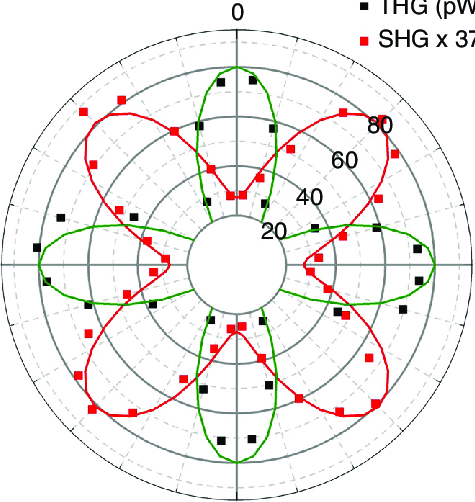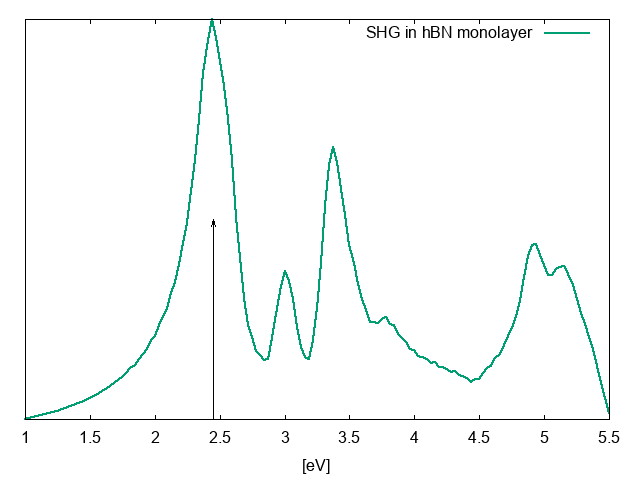Angular dependence of non-linear response: Difference between revisions
| Line 97: | Line 97: | ||
% | % | ||
Field1_Tstart= 0.010000 fs # [RT Field1] Initial Time | Field1_Tstart= 0.010000 fs # [RT Field1] Initial Time | ||
In this input we ask to Yambo to rotate the laser vector aound the z-axis (NLrotaxis = 0.000000 | 0.000000 | 1.000000 ), <br>starting from the vector in the plane Field1_Dir=0.000000 | 1.000000 | 0.000000. | |||
Thefore 0-degree means y-direction, while 90-degree is equivalent to x-direction. | |||
Revision as of 14:53, 23 January 2024
In this tutorial we show how to calculate angular dependence of non-linear response using Yambo. (This tutorial requires Yambo >= 5.3)
We consider as example a monolayer hBN, DFT input files can be downloaded here: hBN-2D-RT.tar.gz
In this tutorial we suppose you already know how to calculate non-linear reponse with Yambo,
if this is not the case please have a look to the tutorials: Non linear response
Run DFT calculation, import the wave-function and run the setup. Then
Remove symmetries
We remove all symmetries Using the command ypp_nl -y
fixsyms
# [R] Remove symmetries not consistent with an external perturbation
% Efield1
0.000000 | 0.000000 | 0.000000 | # First external Electric Field
%
% Efield2
0.000000 | 0.000000 | 0.000000 | # Additional external Electric Field
%
BField= 0.000000 T # [MAG] Magnetic field modulus
Bpsi= 0.000000 deg # [MAG] Magnetic field psi angle [degree]
Btheta= 0.000000 deg # [MAG] Magnetic field theta angle [degree]
RmAllSymm # Remove Time Reversal
notice that in principle one could remove only the symmetries of the rotation plane plus the TimeReversal.
Then go in the FixSymm folder and run the setup again
Run a standard SHG calculation
We first run a SHG calculation using the input
nloptics # [R] Non-linear spectroscopy % NLBands 3 | 6 | # [NL] Bands range % NLverbosity= "high" # [NL] Verbosity level (low | high) NLtime=-1.000000 fs # [NL] Simulation Time NLintegrator= "INVINT" # [NL] Integrator ("EULEREXP/RK2/RK4/RK2EXP/HEUN/INVINT/CRANKNIC") NLCorrelation= "IPA" # [NL] Correlation ("IPA/HARTREE/TDDFT/LRC/LRW/JGM/SEX") NLLrcAlpha= 0.000000 # [NL] Long Range Correction % NLEnRange 1.000000 |6.000000 | eV # [NL] Energy range % NLEnSteps= 160 # [NL] Energy steps NLDamping= 0.200000 eV # [NL] Damping (or dephasing) RADLifeTime=-1.000000 fs # [RT] Radiative life-time (if negative Yambo sets it equal to Phase_LifeTime in NL) % Field1_Freq 0.100000 | 0.100000 | eV # [RT Field1] Frequency % Field1_NFreqs= 1 # [RT Field1] Frequency Field1_Int= 1000.00 kWLm2 # [RT Field1] Intensity Field1_Width= 0.000000 fs # [RT Field1] Width Field1_kind= "SOFTSIN" # [RT Field1] Kind(SIN|COS|RES|ANTIRES|GAUSS|DELTA|QSSIN) Field1_pol= "linear" # [RT Field1] Pol(linear|circular) % Field1_Dir 0.000000 | 1.000000 | 0.000000 | # [RT Field1] Versor % Field1_Tstart= 0.010000 fs # [RT Field1] Initial Time
from this run we get the X2yyy(ω) spectrum:
where we put an arrow at 2.45 eV, the frequency where we want to study the angula dependence of the SHG. Notice that this specrum is not a converged one due to the small k-point grid and the reduced number of bands.
Run SHG at different angles
Using the same command yambo_nl -u n to generate the input at different angles:
nloptics # [R] Non-linear spectroscopy % NLBands 3 | 6 | # [NL] Bands range % NLverbosity= "high" # [NL] Verbosity level (low | high) NLtime=-1.000000 fs # [NL] Simulation Time NLintegrator= "INVINT" # [NL] Integrator ("EULEREXP/RK2/RK4/RK2EXP/HEUN/INVINT/CRANKNIC") NLCorrelation= "IPA" # [NL] Correlation ("IPA/HARTREE/TDDFT/LRC/LRW/JGM/SEX") NLLrcAlpha= 0.000000 # [NL] Long Range Correction % NLEnRange -1.000000 |-1.000000 | eV # [NL] Energy range (for loop on frequencies NLEnSteps/=0 % NLEnSteps=0 # [NL] Energy steps for the loop on frequencies % NLrotaxis 0.000000 | 0.000000 | 1.000000 | # [NL] Rotation axis (for the loop on angles NLAngSteps/=0) % NLAngSteps= 80 # [NL] Angular steps (if NLAngSteps/=0 field versor will be ignored) NLDamping= 0.200000 eV # [NL] Damping (or dephasing) RADLifeTime=-1.000000 fs # [RT] Radiative life-time (if negative Yambo sets it equal to Phase_LifeTime in NL) % Field1_Freq 2.500000 | 2.500000 | eV # [RT Field1] Frequency % Field1_NFreqs= 1 # [RT Field1] Frequency Field1_Int= 1000.00 kWLm2 # [RT Field1] Intensity Field1_Width= 0.000000 fs # [RT Field1] Width Field1_kind= "SOFTSIN" # [RT Field1] Kind(SIN|SOFTSIN| see more on src/modules/mod_fields.F) Field1_pol= "linear" # [RT Field1] Pol(linear|circular) % Field1_Dir 0.000000 | 1.000000 | 0.000000 | # [RT Field1] Versor % Field1_Tstart= 0.010000 fs # [RT Field1] Initial Time
In this input we ask to Yambo to rotate the laser vector aound the z-axis (NLrotaxis = 0.000000 | 0.000000 | 1.000000 ),
starting from the vector in the plane Field1_Dir=0.000000 | 1.000000 | 0.000000.
Thefore 0-degree means y-direction, while 90-degree is equivalent to x-direction.

